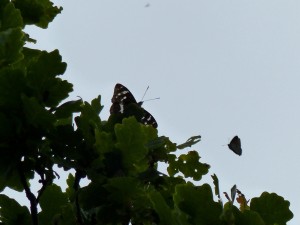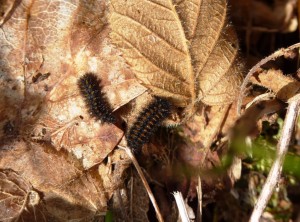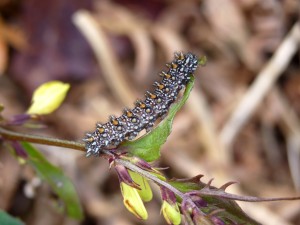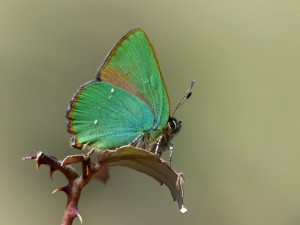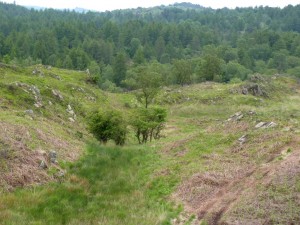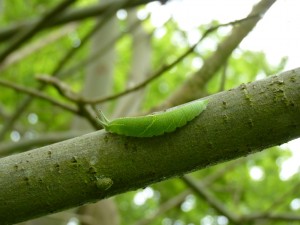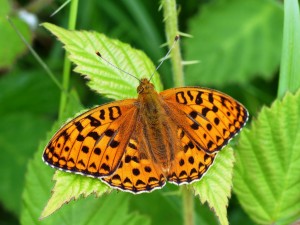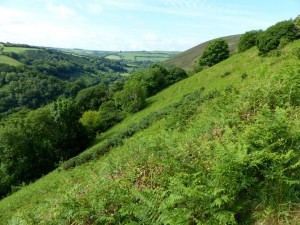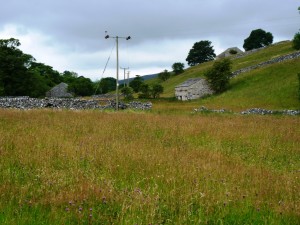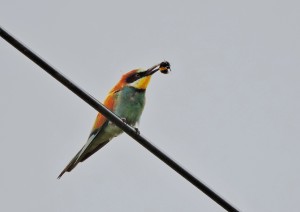Bloomsbury is reprinting the paperback edition of In Pursuit of Butterflies in 2020, to accompany His Imperial Majesty…
Here are the latest updates of my book, In Pursuit of Butterflies (Bloomsbury, 2015). I decided to add new chapters on this website, covering subsequent years, and perhaps some places or landscapes that didn’t make it into the book. These are polished drafts which haven’t been through the rigour of a copy editor.
The book itself is, of course, far too long – I’m sorry it’s so long, but I didn’t have time to write anything shorter.
Here then are chapters on 2015 and 2014.
In Pursuit of 2015…
Diary, Thursday January 1st 2015 –
New Year was seen in, alone, on a mild, moony night on the western edge of Hailey Wood, near Cirencester, beneath a veteran beech tree to which I am curiously attracted. It stands on a wood edge bank, and has huge limbs that droop to the ground, offering a house of sanctuary to lovers of Nature. The firs in Tarlton Bottom were alive with tawny owls, and I disturbed a great many wood pigeons on my walk in from Tarlton Down Corner. Far off, foxes were mating, and making a ridiculous din about it. The forest was shimmering in moonlight, a silvering broken only by the stark black trunks of the sleeping-waking trees – I charged them to dream up the spring, and to dream it slow and deep. There was not a human being – or a car – anywhere within range, the nearest house being a mile off. Yet from just before midnight the sky pulsated with firework explosions which would have been heard on the Western Front. It felt as if people were trying to blow the sky itself up. Such is our relationship with Nature today.
The nature writer Peter Marren, who has researched the symbolism of butterflies in art, has determined that the Red Admiral is a symbol of darkness, sin and death. He’s probably right, for yet again my first butterfly of the year was a Red Admiral, and yet again a substandard butterfly season ensued.
Marren’s work, summarised in his treatise on our relationship with butterflies Rainbow Dust, has made me more than merely paranoid lest my first butterfly of the year should be a Red Admiral, as it was in 2015. In future plan your summer holidays around my year’s first butterfly: If it’s a Red Admiral, or a Peacock, get out of Britain. But don’t blame me, blame Marren.
The good news is that the 2016 butterfly season is unlikely to kick off with a Red Admiral, as this largely migratory butterfly was present only in low numbers in 2015, and disappeared from large parts of the country altogether in late September – I saw my last of the year as early as 9th October, and recorded fewer autumn Red Admirals in 2015 than in any previous year. Good.
Back in early 2015, great promise was in the air. It was almost tangible at times. The winter had been the sunniest on record, though in the whole-UK data set which only runs back to 1929. March had oscillated as only March can, then April became the sunniest on record – though only in the post-1929 data set.
Then, yet again, the malicious demon – or is it a grumpy Greek God – which controls the jet stream, which directs our weather, deemed that the wretched thing should jump south on St Mark’s Day, April 25th, just as things were warming up nicely. The early spring insects were soon blasted away – all the mining bees and their attendant bee flies, the hoverflies, the dangly-legged St Mark’s Flies, and spring’s butterflies. I saw a mere three Grizzled Skippers all spring, not least because it seems to be in the process of dying out from Cirencester Park Woods, my local Grizzled Skipper stronghold. A run of rampant grass growth years may have made the clearings and young plantations there too grassy for a butterfly that breeds on a narrow range of plants, notably Wild Strawberry, which are colonisers of bare ground. Bare ground is at a premium in Cirencester Park Woods now, which may also impact severely on the Pearl-bordered Fritillary population there, the last in Gloucestershire. I am now Officially Worried about the Grizzled Skipper, as it came bottom in my annual Butterfly of the Year contest – a piece of trivial pursuit that flows through my mind each year, threatening at times to become important. Usually the Holly Blue comes bottom, or the Clouded Yellow, for not showing up.
The Marsh Fritillary Show
But the spring of 2015 had its champion butterfly. Once again the Marsh Fritillary made the spring its own, by staging a spectacular come back at Strawberry Banks, the fragment of heaven which is the butterfly’s sole Cotswold locality. Some 4000-5000 larvae were present there during February and March, munching their way through Devil’s Bit Scabious leaves which hardly grew in the absence of early spring rain. To put that number into context, the butterfly nearly died out on the Banks early in 2012, when a mere 52 larvae were present (counted three times, on three different days). Somehow it made it through, recovered, and flourished again in 2015. Here’s a microcosm of what was happening on the Banks this May –
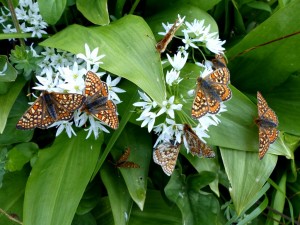
The Large White was also stirring, at least in the Cotswolds. By the end of May I had seen 55, an unusually high tally for a butterfly which is surprisingly scarce until mid-July, when it suddenly proliferates. If the summer was fair the Large White would storm every cabbage patch in Britain, and form clouds dense enough to stall traffic on the M25 – there is always Hope…
But the jet stream’s jump ensured that only two other butterfly species shone in the spring of 2015: the Peacock, which was by far the most numerous of the species which hibernate as adult butterflies, and the Green Hairstreak, which timed its flight season in the Cotswolds to coincide with the best of the April weather.
Ascending the Great Orme
At the end of May the National Trust acquired a small farm on the summit of the Great Orme, the Carboniferous Limestone massif that broods above Llandudno on the North Wales coast. The vendor was no less a mortal than the footballer Dean Saunders, of Liverpool and Wales, who had aspired to turn the 140 acres into a golf course, only to fail to get his act together, tire of the place, and put it back on the market. Parc Farm itself is unimpressive, an intensively managed sheep farm excluded from the surrounding SSSI and SAC that makes the Great Orme one of the most important grassland sites in Europe. However, under something glorious called a Deed of Compromise, the farm holds the grazing rights for most of the Orme’s wildlife-rich slopes. Had the farm become a golf course, the grazing essential to the flora and fauna would probably have ceased, and the Orme would have deteriorated considerably as a wildlife site. Enter the National Trust.
I was asked, first, to visit to help with media events associated with the acquisition, and then with the vision for the farm, and the detail of the nature conservation grazing it can deliver – four days exploring one of the most special and spectacular places in Britain. What a rotten job! Whilst doing a live TV piece on the summit my first Painted Lady of the year appeared, a worn male hill-topping in a limestone crag. Now that was a deeply memorable and symbolic start to the Painted Lady season, promising a greatness from the summer that never actually developed. So often the Painted Lady flatters to deceive, and did so this year.
The Great Orme is renowned for a massive population of a dwarf race of the Silver-studded Blue, subspecies caernensis, and also for a small race of the Grayling, known as subspecies thyone. After a lot of effort I managed to see the first caernensis of the year, on the slopes of Ffynnon Gogorath, on May 27th, though thyone was clearly not out. But oh the joys of Llandudno! Try dining out there: Closed, Closed, “Sorry, sir, we stop serving food at 7pm” (that was a pub, supposedly). Eventually a half-decent Italian. The B&B was also bothersome: at 2am the tattooed gorilla in the next room beat up his girlfriend – in Welsh, with swearing in English. Judging by appearances at breakfast the following morning, the lady won, but then she was a lady of no small consequence.
May ended at Haugh Wood, near Hereford. This is the country’s top Wood White site, though to be honest I have a secret locality nearby where this delicate wanderer of woodland rides occurs in even higher density. There, in a tiny glade, eight male Wood Whites were feeding together on the flowers of milkwort and Birdsfoot Trefoil, whilst a couple of females were laying eggs on the undersides of Yellow Meadow Vetchling leaves, and a Chiff-chaff called incessantly for the return of a spring which had become lost. It is important that the countryside provides us all with secret places, where we can be alone with Nature, and be ourselves.
The last ten days of May saw insect populations in the doldrums, between the premature ending of spring and the delayed arrival of summer. Then June kicked off with a fully-fledged gale, worthy of late October. This was followed by a lovely early summer day devoid of butterflies, then a day of thunderstorms (Belgium got clobbered). Something was brewing.
In Pursuit of Butterflies was first launched at the Gilbert White Museum in Selborne, on Sunday June 7th. It could have been launched on Noar Hill that morning, for the hill was on top form, having recovered from a bad attack of Favourable Condition – a corporate fashion masquerading as nature conservation, wherein all the scrub on the chalk pit banks was cut, over a short period, in a naïve, costly and ultimately futile attempt at clearing it. The Brown Hairstreak, one of the SSSI features of Noar Hill, suffered badly. Scrub likes being cut – it rejuvenates it. But now, the funds had run out and the place was recovering spectacularly, especially the young blackthorn growth favoured by the Brown Hairstreak. The last Duke of Burgundies and Orange Tip of the year were seen here. May is so poor a month nowadays that these two early spring butterflies seldom now persist into June.
But the day ended sorrowfully. I had the ominous feeling that something was wrong in the Straits Inclosure, over in Alice Holt Forest, to the north-east of Selborne. I have an intuitive relationship with this wood: I know what’s going on there, despite living 75 miles away and visiting only intermittently. Sure enough, I discovered that the Forestry Commission contractors, Euroforest, had heavily thinned much of the western half of the wood during the spring. Previously it had been FC policy not to harvest timber there during the nesting season. Now, most of the breeding sallows used by the Purple Emperor in the wood’s western half had been wantonly removed, along with huge swathes of Honeysuckle tangle used by the White Admiral. It was hard not to think that these actions were deliberate.
At the end of June the FC followed up by flail-cutting the whole length of the main ride, thistles and all. Why? Are they deliberately trying to knock out the wood’s butterfly fauna? Perhaps they think that too many butterfly enthusiasts visit the place? The Straits is highly unlikely to become a great Purple Emperor wood again during my lifetime.
In Pursuit… was formerly launched at the Natural History Museum on June 11th. Later, I launched a copy into the Thames. It sailed joyously away.
In mid-June the 2015 butterfly season at last got going. I was on Exmoor, surveying Heath and High Brown fritillaries.
Diary entry, Mon June 15th –
I got ambushed whilst driving from Exford to the top of Porlock Common – by the Painted Lady. I’d passed a couple of singletons, then found a pair of males battling over the possession of a small clump of hill top gorse in the evening sun, around 7pm. They’re back, they’re in, and they mean business. Hopefully the long hot summer of 2015 will now begin. Fancy travelling all the way from the Mediterranean or beyond to squabble over the possession of a lonely hilltop gorse bush… .
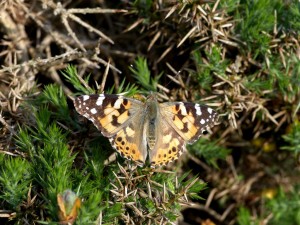
However, the Painted Lady invasion then petered out. And the High Brown Fritillary, though numerous on the Bracken slopes of Heddon Valley on the Exmoor coast, was not in the profusion it had been in back in 2014. And my knees were packing up – nothing taxes knees more than constantly twisting to identify a fast-flying fritillary hurtling over Heddon’s precipitous, Bracken-infested slopes. Try this: breast stroke uphill through pathless impenetrable head high Bracken – disengage feet from hidden brambles underfoot – twist as a male fritillary hurtles past you – Dark-green or High Brown? – stumble onwards a few more stumbling steps – trip over bramble – swim through Bracken – turn ankle on loose stone – twist to identify another manic fritillary… disappear down a hidden rabbit hole into Wonderland. It’s insanity…
First We Take Llandudno
Bruised, bloodied and covered in tick bites, it was time to head back up to the Great Orme, to tackle the conservation grazing plan. The place needs a shepherd ecologist, probably a young couple. Such skills are taught in some French agricultural colleges, but not in the UK’s. The Orme needs a conservation flock of hardy breed sheep, which can be folded at night back on Parc Farm, and shepherded out on the slopes by day. But many of the grasslands and heathlands on the gentle upper slopes have become too rank for sheep, and need cattle. So some small, nimble cattle are required too, with short stocky legs and a low centre of gravity. Traditional Welsh Black cattle would suffice. And all the farm supplies – hay, straw, young stock – have to travel up to the top of the Orme on the tourist’s tramway that zigzags up to the summit from Llandudno! What a life for an energetic, outward-facing young couple with interests in wildlife and farming. They can even dine out periodically in Llandudno.
But the Orme has goats, which have hefted themselves into four areas, high along the Limestone crag tops. Apparently they’ve been there since the latter days of Queen Victoria. At times their numbers have built up so much that problems have occurred – usually in the form of young dispersing males storming Llandudno, in search of pastures new. There have also been issues with goat welfare. All that’s sorted now, with an all-singing all-dancing population and welfare programme. The goats are even ear tagged.
The Orme’s flora is at its richest in the goat heft areas, though the animals do have the habit of eating some rare plants, notably the Welsh Cotoneaster, a UK endemic known only from this area. Of course, there are ungrazed scrub-infested areas which desperately need goats.
This photo is entitled First We Take Llandudno…
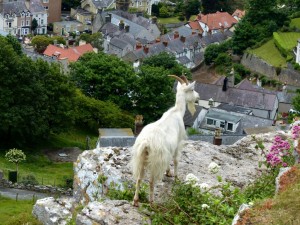
And here’s the slopes of the SW flank of the Orme, around Gogarth. Around Midsummer Day these slopes offer some of the best butterflying in Britain, when the Silver-studded Blue is at peak.
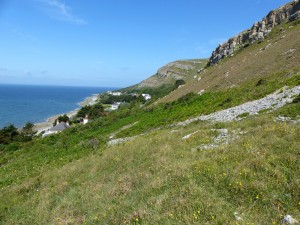
And here are male and female Silver-studded Blues from the Orme –
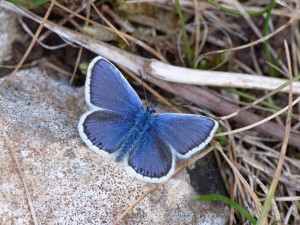
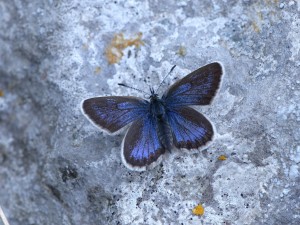
The weather was improving, but the Purple Emperor season was a little way off. There was time for a Mountain Ringlet expedition, incorporating a visit to the Morecambe Bay limestone hills. The butterfly season was running even later there, with Small Pearl-bordered Fritillary still out in numbers alongside a fair scatter of Dingy Skipper. Dark-green Fritillaries and Large Heaths were only just starting, and High Brown Fritillary was clearly some way off (it started there on July 6th).
Yet Another Manic Mountain Ringlet Expedition…
Wednesday July 1st was the hottest July day on record, with 37C recorded at Heathrow. In the Lake District it was sweltering – ideal for yet another masochistic onslaught on the Mountain Ringlet, with partner in crime John Hooson, knees permitting. We went to catch up with research the RSPB is conducting on this poorly understood inhabitant of the high fells.
The RSPB owns or leases a huge area of eastern Lakeland around Haweswater, including an expanse of fell top around High Raise and Kidsty Howes, where they have reduced grazing pressure substantially. Ten years ago they set up 16 ambitious Mountain Ringlet transects, each 1km long by 50m wide. These routes are walked once a year in good weather during the butterfly’s (assumed) peak season period. Of course, montane weather has ensured that good data has been obtained in only half those years, but at least it’s something. One problem is that it takes over an hour to walk up to where the ringlets start, around the 525m contour.
This summer, a post-doc researcher, Steven Ewing, was camping out on Kidsty Howes, studying the butterflies – recording where the females lay their eggs, following the fate of the eggs (most fell off), and even finding the larvae. The latter is a major breakthrough as until recently it was assumed that Mountain Ringlet larvae are nocturnal and impossible to find. Neither of these assumptions is true, and slowly but surely the secrets of the Mountain Ringlet are being unravelled. We even made some progress on July 1st, watching a number of eggs being laid amongst the Mat Grass tussocks.
Kidsty Pike is the peak just right of centre –
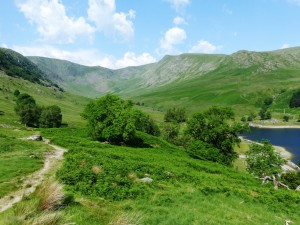
The ringlet was not the only butterfly up on the high fells that scorching day, for Green-veined Whites were numerous around the base-rich flushes some 500-600m up, laying eggs on Ladies Smock which, rather incredibly, was still in flower up there. Whether the butterfly has one or two broods up there is unknown. Certainly it was at peak season that day.
That night a series of spectacular thunderstorms broke out, generating innumerable lightning strikes. Manchester and Oldham were obliterated, and the M6 was flooded for hours. The weather then fell apart in the Lake District, and northern Britain generally, and a miserable summer ensued up there (so poor that snow persisted on some Scottish mountains). This meant that, amazingly, Mountain Ringlets were still flying at Kidsty Howes on August 18th – by far the latest the butterfly has been recorded on the wing in England. The Cumbrian year ended tragically, with extensive flooding and damage to infra structure inflicted by Storm Desmond in early December, which deposited a UK all-time record of 341mm of rain in 24 hours at Honister Pass, up in ringlet country.
Knepp Takes Over…
I had spent much of 1975 Purple Emperor season in the woods a little to the north of Knepp, deep in the West Sussex Weald (see In Pursuit.. chapter 7, nostalgically entitled Walden). Forty years on I was back, not in precisely the same place and certainly not in the same tent, for that had rotted away years ago. But the woods I frequented in ’75 have become a shadowland. I could find no vestige of their old selves there. It was as if they were in slumber, though they will wake again, sometime. Perhaps they have migrated – for places do move (think sand dune, salt marsh, or even a New Forest wood).
Instead, the spirit of ’75 was alive and throbbing in the main block of Knepp Wildlands, 1475 acres of former dairy and arable farmland between Shipley and Dial Post, now developing into new age pasture woodland under the Knepp rewilding project. Perimeter fenced, with all internal fencing removed, the block is grazed as a single compartment by nomadic longhorn cattle, fly-by-night deer and the happiest pigs in Christendom (Tamworths). The tent has been replaced by this shepherd’s hut. Purple Hairstreaks adorn the oak edge there on July evenings, Turtle Doves churr distantly, and in mid-July 2015 a family of Stoats gambolled around joyfully, in full view.
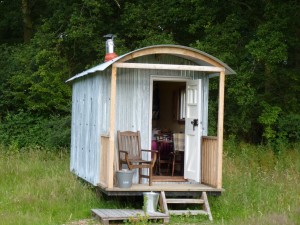
Knepp Wildlands could easily be called Knepp Sallowlands. Between 2001 and 2006, sallow seed rained down on acres and acres of bare clay, as field after field came out of arable rotation or maize production. Rampant sallow thickets, jungles even, quickly developed, despite vigorous browsing in spring by cattle and deer.
One part of Knepp Wildlands, formerly an arable field called 27 Acres, looks like this –
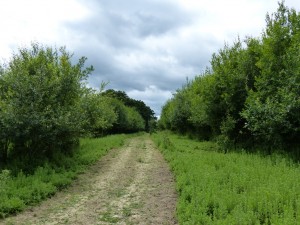
It has been renamed 27 Emperors, after 27 Purple Emperors were counted there in as many minutes late one morning in early July. Most of those were males searching the sallows for females, or soaring over the tall oaks that line the outgrown hedge systems.
Forty years ago the woods to the north boasted a modest Purple Emperor population. On a good day 20 might be seen there. Forty years on, the Emperor has erupted to the south: Knepp Wildlands now support the largest population in the country, thoroughly outgunning the mighty Fermyn Woods up in Northamptonshire (in what was a poor Purple Emperor season). Not bad for a butterfly which only intermittently wandered through Knepp when the land was intensively farmed.
Moreover, the Emperor’s conquest of Knepp finally dispels the myth that it is an ancient woodland butterfly and of necessity a great rarity; for Knepp is the equivalent of a brownfield site, of very recent origin, and no butterfly needs, or wants, to be rare. Above all, the Emperor is a butterfly of scrubland, with an abundance of sallow. Vast amounts of sallow are needed, as relatively little of it is in suitable breeding condition at any one time. The Emperor’s problem is simple: foresters hate sallows, regarding it as a weed – hence the eradication of so much sallow in Alice Holt Forest Straits Inclosure, and elsewhere. The Emperor is a victim of inherent and ill-founded prejudice.
The Knepp Estate is developing wildlife tourism, partly as a business venture and partly to win converts over to the concept of rewilding. Wildland safaris take place almost throughout the year, including Nightingale nights in spring (34 singing males in 2014), deer rutting days in the autumn, and the best of all, Purple Emperor Safaris on weekends in July, led by Messrs Hume & Oates.
The Purple Emperor population at Knepp is now so vast that on Sunday July 11th Messrs Hulme & Oates guided a group to to see 100 Purple Emperors, in a short day punctuated by a long, leisurely and utterly luxurious lunch beneath a mighty spreading oak, and side tracked by close encounters with ecstatic Tamworth pigs and piglets, and Turtle Doves. Here’s the party celebrating the century –
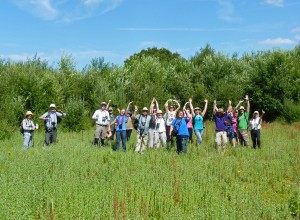
To put this into context, prior to that day only four people had managed to score a century of Emperors in a day, ever. Hume & Oates calculated that had they not been leading a group that day, and had they worked longer hours and covered more of the 1475 acres, they might have scored a double century, each… So much for the old day-target of 20… Next year, 200; thereafter, Bradman’s 334; then Lara’s 505. We need some ambition in Emperoring.
But the highlight of the 2015 Purple Emperor season was the evening of July 16th. The day had been spent discovering a small population of the butterfly in the woods at Sissinghurst, near Cranbrook in Kent – unchartered territory. I arrived back at Knepp at 6pm, expecting to witness a short evening flight, only to experience one of the most amazing episodes I’ve had with this the best of all possible butterflies. Wandering down the green lane that runs north to south through the Wildlands, Purple Hairstreaks were numerous – having a good year for once – and I ticked off five malcontent male Emperors up in the oaks; then spotted a female spiraling down, rejecting the advances of two amorous males, and almost crash-landing into the grasses by my feet.
Shortly after, I realized why they had met – they’d been feeding on sap runs on one of the veteran oaks along the green lane. Then, between 7.20 and 8.30 at least six males and three distinct females visited these bleeds, favouring a diseased kink in a horizontal bough 25’ up, where up to four were seen feeding at once – combinations of four males, three males and a female, and two males and two females together. The males were middle aged, but one of the females seemed pristine. By 8.45 only a lone male remained. He was still there in the gloaming when I left at 9.05, with rain starting and thunder a lightning rampaging to the west.
The light was so poor that evening that my own photos were a trifle disappointing, but I broadcast the location on the Emperoring grapevine and arranged for a ladder to be erected up the diseased tree. Several other Purple People visited and obtained some superb photos, though the season and the weather were both on the wane by then.
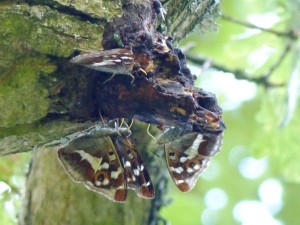
Perhaps their predilection for oak sap, and its ready availability, explains why Knepp’s Purple Emperor’s do not descend to feed on the tracks, unlike their cousins in Fermyn Woods, where the oaks are much younger and less sappy? Only two males were photographed on the ground at Knepp all season. Sap might also explain why the Knepp males are so violent, and their Fermyn cousins so placid? We have had to erect health and safety warning notices –
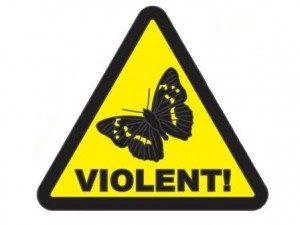
Homage to Chattenden
Emperoring began in earnest back in the mid-Victorian era at Great Chattenden Wood near Rochester in Kent. Before the New Forest came on stream, with the arrival of the railway, Chattenden was London’s main collecting ground for woodland butterflies; and the primary quarry was of course iris. There are startling descriptions of sterling doings there, mainly in Frohawk and Tutt. These are summarised in Heslop. Males used to assemble on low oaks on the summit at the west end of the woods, at a cross-rides, where collectors used to capture them with ‘high nets’, about 15’ tall. Baits were also used. Frohawk states that a pair of collectors caught 97 Emperors ‘in a few days’ on dead animal baits there. Then, according to Frohawk the butterfly suddenly and rather mysteriously died out in Chattenden, circa 1887, presumably because of widespread felling of sallows (though habitat descriptions are lacking). Heslop disputes that date, pointing out that collecting permits were issued into the 1920s – expressly for catching Purple Emperors.
Great Chattenden Woods were taken over by the War Department during the First World War, and much woodland was cleared for encampments. Most of what was once Great Chattenden Woods is still owned by the MOD, which has been trying to sell the land for development. As that land is designated as SSSI, primarily for Nightingales, a mighty rumpus has developed. Lodge Hill, as the potential development land is known, has been much in the news lately, with government labelling it as brownfield land suitable for development. It is not brownfield, it is an ancient woodland site which was partly cleared during the Great War. It should be restored to woodland, and the glory that was once Great Chattenden Wood would rise again.
The great news is that iris is back in Chattenden – if it ever left. Better, the males are still assembling over now-stunted veteran oaks at the cross-rides on the summit of the hill at the wood’s western end. I saw my last of the season there, at the ending of July. Habitat conditions look impressive, with an abundance of quality sallows along the lower slopes. The butterfly is undoubtedly breeding on sallows on the Lodge Hill land too.
First, we retake Chattenden, then we take the world…
It was here that the Purple Emperor won Butterfly of the Year 2015, though the main battle had been won at Knepp.
The Clouded Yellow’s Return
What do you do when the party’s over? Find another party.
Dear Martin Warren, Chief Exec of Butterfly Conservation, spent the last days of July and the start of August walking the Purbeck coast footpath, to raise funds to assist the conservation of our rarest butterflies – the High Brown Fritillary, Duke of Burgundy and Wood White. Being Martin, the sun shone miraculously throughout, and his walk raised a massive £14,000.
He asked me and John Ingham, from The Daily Express to join him for the grand finale on Sunday August 2nd, the stretch from Worth Matravers to Swanage. The butterflies rolled out the red carpet for us, particularly the Lulworth Skipper – that denizen of the Purbeck limestones which gets categorised as a little brown job, and is consequently rather ignored. Though tiny and prone to mucking about amongst rough grasses, it’s a sweetheart, and relatively easy to photograph too – a beginner’s butterfly. Butterfly Conservation has been worried about it lately, as it’s declined on Purbeck, and been lost from many former strongholds. In some instances this decline is due to conservation grazing, for it favours rough grassland slopes where its foodplant Tor Grass, a thug of a grass, proliferates, but there are other, mysterious factors at play too. Also, its flight season has shifted forward, so that it is usually well on the wane by the start of August, traditionally its peak season period.
But on this day, it was profuse in many places between Worth Matravers and Durleston Head, notably around the Winspit and Seacombe quarries, above Dancing Ledge and around Blackers Hole, on Belle View and on Durleston Head. Martin, who lives in Dorset and knows this skipper well, was most impressed by what we saw of it.
The highlight, however, was the appearance of the first Clouded Yellows of the year, in a sheltered flowery combe between Dancing Ledge and Blackers Hole, moments after Martin had announced: “Here’s the place for a Clouded Yellow!” – that golden wanderer from sunnier climes whose appearance in the UK almost invariably heralds good summer weather. First, one pristine male patrolling the length of the little valley at speed, then a second equally perfect male quartering the lower slopes. Of course, they met, and squabbled terribly, spiraling up into a cobalt sky together. Our guess was that they’d just arrived in off the sea. We left them to it.
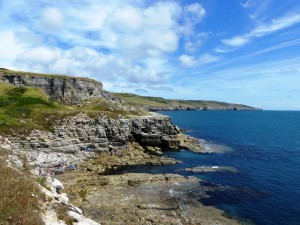
Revenge!
Forty summers ago England was well beaten by the Australians in an Ashes series shortened by the first ever cricket world cup. Only the silver-haired David Steele, from Northamptonshire, and my batting hero John Edrich were able to resist the might of Dennis Lillee and Jeff Thomson, backed up by ‘Tangles’ Walker, who rather blew England’s batting away.
Forty years on, revenge proved sweet, most notably on Thursday August 6th when England annihilated Australia at Trent Bridge, bowling them out for 60 in a mere 18.3 overs (Stuart Broad 8-15). I was visiting an old stomping ground, Stockbridge Down in west Hampshire, with National Trust colleague, ranger Catherine Hadler. Poor Catherine, she didn’t know what was going on – but realised it was Mega and entered into the spirit of a glorious day. So did Stockbridge Down, where butterflies and flowers are booming now that the Rabbit population has died down. For much of the nineties this down was hammered by Rabbit grazing, such that in dry summers hardly a vestige of grass showed. Downland recovers splendidly from Rabbit abuse.
This year, the down looked the best it’s looked since the early 1980s, offering a profusion of Chalkhill Blue and a wealth of other butterflies. Brimstone was highly impressive, with a major hatch that day. We counted 19 on one wild Buddleia bush on the edge of the bottom car park.
But why can you never find an Australian when you need one?
The Brown Hairstreak Show, and a Butterfly Collector
Before visiting Stockbridge Down I’d called in at Shipton Bellinger Roughs, a jungle of MOD-owned scrubland punctuated by rough grazing fields on the Hampshire – Wiltshire border. This may well be the UK’s top Brown Hairstreak site. I was only there for 15 minutes but managed to see eight Brown Hairstreak males, active in warm drizzle just after 9am. The diary entry concludes: ‘Must return ASAP, as this is most promising…’.
After a week in Cumbria, sorting out the grazing regime on Arnside Knott, I did return, on Saturday August 15th. Brown Hairstreak males bat around like mad early in the morning, presumably searching for females in need of male services. They are most active between 8.30 and 10.00. That Sunday I arrived at 8.55, having overslept, but the butterflies were making up for lost time as the previous two days had been wet, with all species grounded.
In 2 hours 15 mins, 30 minutes of which were cloudy, I counted 76, repeat 76 Brown Hairstreaks, finishing with a vista of seven as the sun broke through after a cloudy spell. Nearly all were male – I noted only three females. It is likely that many had emerged this morning. This appears to be the most Brown Hairstreaks anyone has ever counted, though it must be added that butterfly counting is a relatively new activity and that this butterfly has declined monumentally in recent decades. Had I arrived at 8am, as planned, and had it not clouded up, as forecast, I may well have reached the hundred. Had that happened, and had August not deteriorated badly, the Brown Hairstreak would probably have won Butterfly of the Year.
As I was leaving, to meet up with Stephen Moss at Broughton Down, the butterfly photographers arrived, along with my first butterfly collector in decades – a Ghurka by appearance. Whatever, he was either unwilling or unable to speak English, though he was clearly after Brown Hairstreaks – there was little anyone could do: the site is not an SSSI, a nature reserve or anywhere covered by wildlife bylaws, and the Brown Hairstreak is not a protected species. All one can do is ignore, or perhaps let tyres down…
Summer Ending
August started well but fell spectacularly from grace. Clouded Yellows same in at the start, and Long-tailed Blues appeared along the Kent and Sussex coast on the 8th. But the second half of the month was very poor, especially in the west and most especially up north – indeed the north had a foul summer. August grew wetter and wetter, only for fine weather to return just after the schools reconvened in early September. This was too late for the butterflies, and a pleasant early autumn was marked for a dearth of butterflies, with the Red Admiral a notable absentee away from southern coasts.
The summer of 2015 was at best mixed. There were fine spells during much of April, from the second half of June into mid-July, at the start of August and then during most of September and October. But the rest of the butterfly season saw a lot of wet and windy weather – the sort of weather which blasts winged insects to kingdom come. Indeed, it was a remarkably windy summer.
What matters now is next year, which will be 40 years on from the long hot summer of ’76, the ultimate butterfly summer of the modern era. We are seriously overdue a good summer, having not had one since 2006 – 30 years on from the long hot summer. Make no mistake, no way will the long hot summer miss out on her 40th anniversary. Jack in the job, cash in the pension, sell your children into slavery, pack the spouse off to the mother in law’s, and cast yourself upon summer’s shores. I’ll be there.
